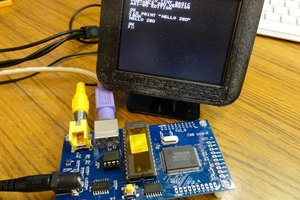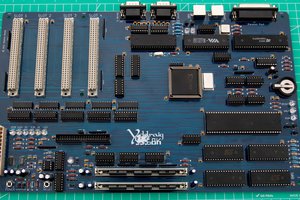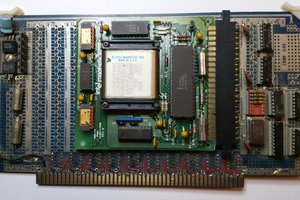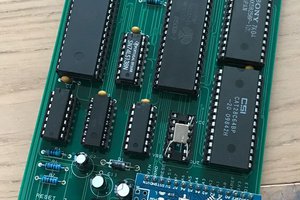NOVA 445
A Data General NOVA-compatible computer based on the Fairchild F9445 microprocessor
A Data General NOVA-compatible computer based on the Fairchild F9445 microprocessor
To make the experience fit your profile, pick a username and tell us what interests you.
We found and based on your interests.
asm445.plCrufty absolute assembler for NOVA 445 RAM code. Written in Perl, generates .AB (Absolute Binary) files per Data General document 093-000003-06 (Binary Loader User's Manual).pl - 35.27 kB - 12/05/2020 at 02:47 |
|
|
asm445-r.plCrufty assembler for NOVA 445 ROM code. Written in Perl, generates .hex files for low & high byte.pl - 31.60 kB - 12/05/2020 at 02:46 |
|
|
LDTST.LSTExample program used to test absolute assembler & binary loader.lst - 5.69 kB - 12/05/2020 at 02:42 |
|
|
schematics033120.pdfPreliminary Graphics processor board schematics (subject to change)Adobe Portable Document Format - 500.89 kB - 04/01/2020 at 02:23 |
|
|
RAMTST.LSTExample asm445 listing output (Monitor RAM test)lst - 3.21 kB - 03/21/2020 at 20:34 |
|
|
Found & fixed a bug in the assembler.
Uploaded new version of asm445.pl
Create an account to leave a comment. Already have an account? Log In.
Super cool to see a "resurrection" of this fascinating and powerful CPU! Given that all the NOVA fans are here, I have a question... I am very interested in microcoding (as you can see from my projects), and I know that NOVA 4 was implemented using Am2901 slices. Does anybody have schematics and microcode listing for that particular CPU implementation?
I'd be surprised if you could find such Data General documentation in the wild. However, the Xerox Alto is well documented and "emulates a virtual machine whose characteristics are approximately those of the Data General Nova." But it doesn't use the Am2901...
AltoHWRef.part1.pdf (bitsavers.org)
AltoHWRef.part2.pdf (bitsavers.org)
Thank you for these links! While not Am2901, 74181 + register file is pretty much close, and also driven by microcode (btw, I am blown away how much even the syntax resembles the microcode compiler I concocted)
Any updates on this design? I have two F9445 chips myself and would be interested in seeing what you come up with. I'd also love to find a 9470 console chip, if anybody has one!
Update posted.
I don't know how many of the support chips actually exist. The datasheets that are out there on the web say "Advance Product Information" for the FPP (9443), MMPU (9444), DMC (9446), IOBC (9447), PMI (9448). The F9470 does appear to be an actual part as of the January 1983 Microprocessor Products Data Book. A web search does show www.4starelectronics.com claiming to have 46 9470s (and maybe some F9444s? These may be an 8-pin microcontroller) in stock as of right now...
Thanks for the pointer. I submitted an RFQ for qty 2 F9470s, and I'll post if I get a response. I'm not hopeful, but maybe I'll get lucky. Have you posted a schematic for your Nova 445? I'm not familiar with I2L logic, and I'm interested to see what you did with the Iinject pin. Did you just use a resistor to Vcc, or did you implement a constant current source to drive it? Thanks again.
I haven't posted the schematics yet. I usually like to wait a while until any major mistakes reveal themselves :-)
I just used a 10 ohm resistor (10W/TO-126 case + heatsink -- you can see it below the CPU socket in the thumbnail for the "Introducing..." video) for the Iinj. I don't think it needs anything fancier than that. One thing about the processor though: a logic '1' output is only about 3.6V. In spec to drive a TTL load, but much lower than what you're probably used to seeing in typical TTL/NMOS/CMOS circuits...
Thanks. It'd be easy enough to construct a constant current source using a 3 terminal linear regulator, but I don't really understand all the trade offs in how this affects the operation of the uP. Good to know that a simple resistor will work.
I was aware of the TTL output levels; I'm planning to use 74HCT or ACT parts for things that are directly driven by the 7445. These are CMOS parts with input thresholds skewed to match bipolar TTL.
OK, I've posted the current schematics for the CPU Board.
I used a mix of different happy families of chips. Mostly 74F (and U5/U6, though shown in the schematic as AS, are actually F), but some S and LS (had 'em) and the bus transceivers (U8/9, U20/21) are ABT... Then there's a plain old 7406 & 7407 and one ALS part just for good measure (U14, shown in the schematic as an S) Date codes range from 1977 to yesterday :-)
Great! Looking forward to seeing this bit of computing history come alive again.
Did you happen across the CPU or did you purposely seek it out? I notice that it uses I3L. I2L was described in https://hackaday.io/project/159059-adventures-in-time-integrated-injection-logic
I sought it out. The DGC Nova was the first computer I used/learned about/programmed, and I actually interviewed at Fairchild back when its predecessor, the F9440, had just been released.
They are quite hard to find these days, but I managed to acquire two...
Become a member to follow this project and never miss any updates

 kodera2t
kodera2t
 Stephen Moody
Stephen Moody
 Denver
Denver
 Ruud van Falier
Ruud van Falier
Hi, Steve! This is SUCH a fantastic project you've created, congratulations creating such a cool vintage DG Nova "Homebrew". I don't know what took me so long to find your work here, I think Google searches have failed me for years in this area.
I run a small group of Nova restoration enthusiasts on my Discord server, Forgotten Machines. We would love to have you join us! I sent you a private collaboration request, thanks!